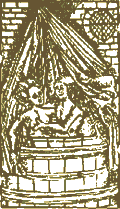Free Spirit Notes
last updated: 31.x.2004
page status: update work in progress
These rituals are a complete flight of fancy. Having researched Christian mystics from 1100 to 1300, who could have been members of the Free Spirit movement, I was talking with Jack Gale who suggested setting scholarship aside for a moment or two and attempting to ‘reverse engineer’ a Free Spirit ritual. It turned out to be a lot of fun: using candles to represent the Living Light, and thus to make the space sacred, are my only two actual concessions to the Priestess Madeleine, all the other elements being taken directly from writings of women Christian mystics. All of this material could have been available to Madeleine’s order and thus could have formed part of what she and John were doing in Glastonbury.
I started with about 35,000 words of potential text, from Hildegard of Bingen to Beatrijs of Nazareth and many in between including Marguerite Porete, and identified certain themes. Much of their writing uses intensely erotic metaphors to represent elements of the contemplative life and of the desire for union with the divine. Some of the symbolism wouldn’t be out of place in modern-day Wiccan ritual, so if we leave aside the metaphor part, voila, we have a sacred marriage ritual.

As well as being fun, the work had a slightly unexpected side effect: the rituals work. Although the sacred marriage is intended to be explicit, as with the Wiccan Great Rite the ritual(s) can be performed in token. One of my correspondents has performed the shorter working twice and reports that on one occasion she and her partner did have ritual sexual intercourse, and on the other they did not, in neither case had they made a conscious decision in advance. You don’t even need to work naked, although if you don’t then using some form of special clothing such as ritual robes does add to the effect.
The order of the elements is taken from Hildegard, but the system is directionless. If you wish, you can assign directions to suit the place or operation, but it’s not really necessary and wasn’t something that was done during the period. I envisaged four bowls of water each containing a small floating votive that can be left safely to burn out. There are assignments for the elements in the ritual. If colours are used, for example for the votives, the defaults would be red (fire), black (earth), blue (water) and yellow (air), in that order clockwise.
Note that with the addition of a bowl of water within the space, a complete circle of a large number of white candles, as described by Jack in ‘Circle and the Square’, will work fine. To simplify the logistics even further, the symbolism will also work with a single bowl of water containing a single white candle: flame is fire, water is water and smoke is air
.The other ingredients are part of the casting ceremony. You need a single spill long enough to light all the candles. Salt represents earth and is ideally dispensed from a small bowl or spoon with a hole or notch in one side, rather than strewing pinches by hand.
Wine represents spirit. Once one has drunk wines from the full barrel, the bouquet alone makes you inebriated and you will never be other. This isn’t just saccharine – what’s happening here is the use of a trigger and this particular one has a very long history behind it. The chalice should be brim-full.
The last tool is a cut flower or greenery to place in the water: a white lily might be best of all, but any symbol of a living thing will do: a leaf and berry in deepest winter, for example. It's brought by the Lover as a gift...
Ideally, the operatives, here designated "Handmaiden" and "Lover", should be naked. According to a couple of contemporary woodcuts, water can be represented by a large, full, wooden bath lined with silk to prevent splinters - hot tubbers please take one step forward. Or, equally over the top, the space could contain a soft mattress surmounted by a tent-like silk canopy. In either case the candles should be kept clear of the silk. You could of course use a barn (with apologies to Jack’s description of the scene in the Abbey Barn), in which case candles should be kept clear of the straw.
Once I’d completed the longer version (at about 1000 words) my partner suggested that it could usefully be significantly shorter. In the days before reading and writing were commonplace, people were much more used to memorising long texts. I figured that it would be a useful exercise and it’s true that the shorter version is the only one we, or anyone else I know, have performed, but there's a limit to how far it can be pruned before it becomes like Marguerite Porète's Mirror: empty. The opening is necessary to set up the sacred space. The closing is necessary both for grounding and for the closing speech. The invocations are not just necessary, but the main part of the work: I've shaved thirty or so words off them. And the closure is necessary but I've lost three of the speeches. As always happens, I learned a lot about what’s actually happening, and fed the results back into the longer version, which I tightened up somewhat.
ritual index
ffetcher
ravenfamily
next: other rituals
skip to: novenas
